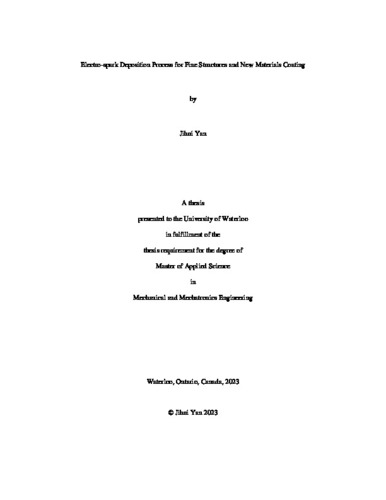UWSpace will be migrating to a new version of its software from July 29th to August 1st. UWSpace will be offline for all UW community members during this time.
Electro-spark Deposition Process for Fine Structures and New Materials Coating
| dc.contributor.author | Yan, Jihui | |
| dc.date.accessioned | 2023-08-21 17:52:11 (GMT) | |
| dc.date.available | 2023-12-20 05:50:05 (GMT) | |
| dc.date.issued | 2023-08-21 | |
| dc.date.submitted | 2023-08-08 | |
| dc.identifier.uri | http://hdl.handle.net/10012/19727 | |
| dc.description.abstract | The electrospark deposition (ESD) process can be used in industry to apply coatings and repair components. It uses a rod-shaped conductive material as the raw material for the electrode, which is melted by the high temperature of the process of discharging to form an electric spark during contact with the substrate, which is then transferred and solidified to the substrate surface. The speed of this process is also accompanied by the melting of the substrate surface, which fuses with the electrode material to give a mixed layer at the interface between the coating and the substrate. However, the deposition process is extremely fast and thus the heat input is small, which has little to no effect on the properties of the substrate. Because the temperature at which electrical sparks are generated is much higher than the melting point of all materials, ESD can make coatings from almost any conductive material. Some materials can also be manufactured into thick buildups with ESD. This process can be treated as an additive manufacturing technique, which can be used to perform the structural repair of damaged parts with fine structures, such as thin wall geometries, thus reducing the cost of replacement parts and reducing the scrap waste of damaged parts. The repair of damaged thin-walled structures with Inconel 718 is described in Chapter 3 of this report, which includes optimization of parameter sets during the manufacturing, and analysis of microstructure, microhardness, and heat-affected zone (HAZ). The high temperature in the process of manufacturing a coating with ESD melts the electrode and the substrate, but if there is a conductive interlayer between the two, such as a layer of metal powder, the high temperature of the spark will melt the powder instead, which then fuses and solidifies on both the substrate and electrode so that the transfer of electrode material can be prevented. Therefore, ESD will be used to fabricate the M/HEA coating using powder as the interlayer that will be presented in Chapter 4, as well as the optimization of the manufacturing process, and analysis of microstructure, as well as the wear resistance of M/HEA coating fabricate using electrospark powder deposition (ESPD). Some application trials with ESD are performed and will be presented in Chapter 5, which describes the repairing of thin walls using manual ESD and automated ESD. The fabrication of high entropy alloy (HEA) coatings with the conventional ESD process will also be presented as a HEA coating trial, along with the discussion of microstructure, microhardness, and the wear resistance of this HEA. | en |
| dc.language.iso | en | en |
| dc.publisher | University of Waterloo | en |
| dc.subject | electrospark deposition | en |
| dc.subject | Inconel 718 | en |
| dc.subject | thin-wall repair | en |
| dc.subject | high-entropy alloy | en |
| dc.title | Electro-spark Deposition Process for Fine Structures and New Materials Coating | en |
| dc.type | Master Thesis | en |
| dc.pending | false | |
| uws-etd.degree.department | Mechanical and Mechatronics Engineering | en |
| uws-etd.degree.discipline | Mechanical Engineering | en |
| uws-etd.degree.grantor | University of Waterloo | en |
| uws-etd.degree | Master of Applied Science | en |
| uws-etd.embargo.terms | 4 months | en |
| uws.contributor.advisor | Peng, Peng | |
| uws.contributor.advisor | Zhou, Norman | |
| uws.contributor.affiliation1 | Faculty of Engineering | en |
| uws.published.city | Waterloo | en |
| uws.published.country | Canada | en |
| uws.published.province | Ontario | en |
| uws.typeOfResource | Text | en |
| uws.peerReviewStatus | Unreviewed | en |
| uws.scholarLevel | Graduate | en |

